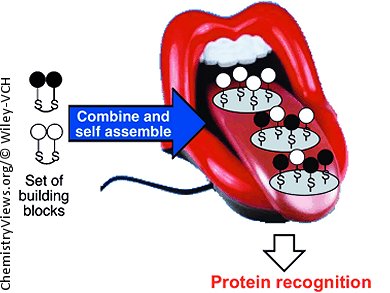Electronic Tongue for Protein Analysis
Electronic noses are used to sniff out exhaust fumes and assist with quality control of foods. Less well known is the fact that equivalent devices, electronic tongues, are capable of recognizing dissolved substances. In the journal Angewandte Chemie, French researchers have now presented a new and particularly simple approach to making an electronic tongue that can differentiate between proteins.
Biosensors use specific ligands, such as antibodies, that selectively bind the molecules being detected. If the goal is to differentiate between different substances, a suitable ligand must be developed for each substance – a complex undertaking. In contrast, electronic noses and tongues use an array of different “receptors” that bind to the desired compounds with differing strengths. The receptors are sensitive toward multiple target molecules. The combined response of all receptors gives a specific pattern for each of the compounds detected. Because none of the receptors needs to be highly specific, they can be developed much more quickly and easily.
A consortium headed by Yanxia Hou, David Bonnaffé, and Thierry Livache is seeking to further reduce the difficulty involved in designing and producing electronic tongues. Their receptors are made from mixtures of a few molecular building blocks with different physicochemical properties. Individual droplets containing different concentration ratios of the building blocks are deposited directly onto the gold surface of a detector. Through a self-assembly process, these form the receptors in the form of tiny spots of molecular monolayers with varying compositions. Surface plasmon resonance imaging was used for detection: the electron oscillations (plasmons) measure change when molecules are adsorbed by the receptors on the detector.
3D Landscape Characteristic of the Protein
To test out their new idea, the researchers took inspiration from the heparan sulfates, which are found on the surfaces of cells and recognize various mediator molecules like growth factors that play a role in many physiological and pathological processes. Heparan sulfates are polysaccharides with different arrangements of sulfate side groups and different binding specificities. The researchers synthesized two components similar to heparin sulfate, one with sulfate side groups and one without. They used mixtures with varying ratios of these components to produce an array of new receptors and tested it with different proteins. A plot of the intensity of the responses for each receptor gives a continuous profile or a 3D landscape characteristic of the protein that can be used for its identification in a greatly simplified manner. Profiles for mixtures of proteins could also be used to identify the individual components by computer.
By introducing more building blocks, the diversity of the receptors used in this first version of the tongue is currently being enriched. This will allow differentiation between very similar proteins in the future.
- Continuous Evolution Profiles for Electronic-Tongue-Based Analysis,
Yanxia Hou, Maria Genua, Dayane Tada Batista, Roberto Calemczuk, Arnaud Buhot, Pauline Fornarelli, Jamal Koubachi, David Bonnaffé, Els Saesen, Cédric Laguri, Hugues Lortat-Jacob, Thierry Livache,
Angew. Chem. Int. Ed. 2012.
DOI: 10.1002/anie.201205346




